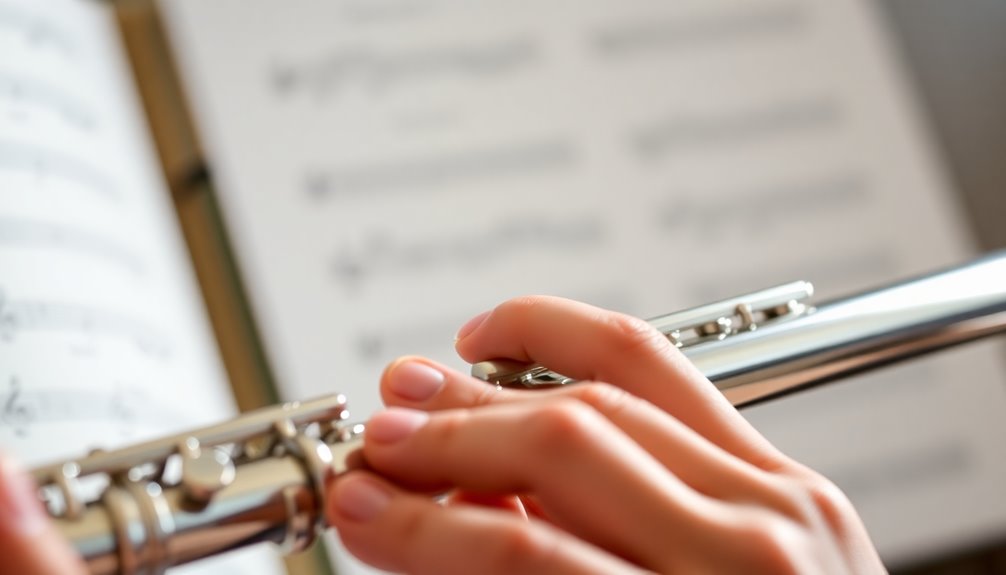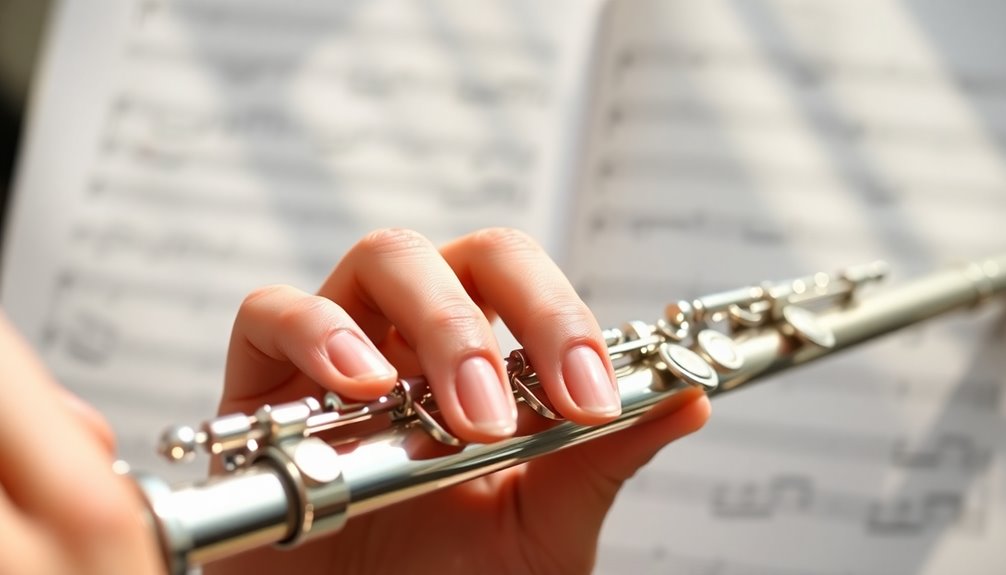Boosting your finger agility on the flute is essential for playing rapid passages and intricate rhythms. Start by incorporating simple exercises like scale variations at a slow tempo to build coordination. The "four-finger" drill can also enhance muscle memory. Avoid common mistakes by focusing on finger independence and maintaining proper posture during practice. Use a metronome to refine your timing and guarantee precision. Don't forget to record your sessions; it helps track progress and boosts motivation. As you explore these techniques, you'll discover more ways to enhance your agility and overall performance.
Key Takeaways
- Start with slow practice of major scales and gradually increase speed to build fundamental finger agility and coordination.
- Incorporate the "four-finger" drill to enhance muscle memory and improve finger independence for rapid passages.
- Use a metronome to maintain timing while practicing finger patterns, helping to develop dexterity and precision.
- Regularly record and review your practice sessions to evaluate progress and identify areas for improvement.
- Maintain proper posture and embouchure to support optimal finger movement and enhance overall sound quality.
Importance of Finger Agility

When it comes to playing the flute, the importance of finger agility can't be overstated. Your fingers need to move quickly and accurately to create beautiful melodies. Finger speed is vital; it allows you to execute rapid passages and intricate rhythms without hesitation. Without this agility, even the simplest piece can become challenging, leading to frustration that can dampen your love for music.
To develop finger agility, you'll want to incorporate dexterity drills into your practice routine. These exercises aren't just for professionals; they're essential for every flutist, no matter your skill level. By dedicating time to these drills, you'll notice significant improvements in your finger coordination and overall performance. The more you practice, the more you'll feel your fingers becoming nimble and responsive. Additionally, using finger guides can further enhance your technique and accuracy.
Remember, mastering finger agility is a journey, and it's important to celebrate your progress along the way. Start slow, focusing on accuracy before increasing your speed. This method not only builds confidence but also reinforces the muscle memory you'll rely on during performances.
Engaging with fellow flutists can further enhance your practice. Share your experiences, exchange tips, and encourage one another to tackle challenging pieces. After all, you're part of a community that values growth and support.
Recommended Finger Exercises

To boost your finger agility effectively, incorporating specific exercises into your practice routine is key. Start with simple finger exercises that focus on coordination and speed. One effective method is to practice scale variations. Begin with a major scale, playing it slowly while focusing on each finger's movement. Gradually increase your speed as you become comfortable.
Next, challenge yourself with advanced fingerings. This won't only improve your agility but also deepen your understanding of the flute's mechanics. Try playing chromatic scales or arpeggios, alternating fingerings for each note. For instance, practice C major using both standard and alternate fingerings. This exercise enhances dexterity and helps you become more versatile in your playing.
Another great exercise is the "four-finger" drill. Choose a note, like B, and practice finger combinations using four fingers in various sequences. For example, alternate between index, middle, ring, and pinky fingers. This helps build muscle memory and coordination, allowing your fingers to move fluidly across the keys.
You can also incorporate rhythm into your exercises. Clap out different rhythms while fingering a scale, which will improve your timing and coordination. Regular use of finger stretchers can also significantly boost your finger strength and dexterity.
Remember to be patient with yourself. Regular practice of these recommended finger exercises will lead to noticeable improvements in your agility. As you progress, you'll find that your ability to tackle complex pieces will increase, making your flute playing more enjoyable and fulfilling.
Keep pushing yourself, and enjoy the journey!
Warm-Up Routines for Flute

A well-structured warm-up routine is crucial for flute players to enhance their performance and prevent injury. By focusing on breath control and posture alignment, you'll set the stage for a productive practice session. Here's how to get started:
- Begin with Breathing Exercises: Spend a few minutes practicing deep breaths. Inhale through your nose and exhale slowly through your mouth. This not only relaxes you but also improves your breath control, which is essential for flute playing.
- Focus on Posture: Stand or sit with your back straight, shoulders relaxed, and feet shoulder-width apart. This alignment promotes better airflow and reduces tension, allowing you to play more freely.
- Finger Warm-Ups: Start with simple finger exercises. Play scales slowly, paying attention to your finger placement and speed. Gradually increase the tempo while maintaining clarity in each note.
Incorporating these elements into your daily routine will greatly boost your confidence and performance. Additionally, focusing on breath support can enhance your overall sound quality and dynamics.
Remember, it's not just about playing notes; it's about creating a harmonious connection between your body and the flute.
As you warm up, allow yourself to enjoy the process. Celebrate the small victories in your technique.
With consistent practice, you'll notice improvements in agility and overall sound quality.
You're part of a vibrant community of players, and together, you can grow and inspire each other. Embrace your journey, and let your passion for music shine through!
Techniques for Improved Coordination

Building on your warm-up routine, enhancing finger coordination is essential to fluid playing and can greatly elevate your musical expression. To develop this significant skill, you can incorporate specific techniques that focus on finger independence and coordination drills.
Start with simple finger exercises that isolate each finger. For instance, try lifting each finger sequentially while your other fingers remain pressed down on the keys. This exercise helps you gain better control and awareness of each digit. You might also want to practice scales or arpeggios, deliberately focusing on smooth shifts between notes. As you play, pay attention to how each finger moves, ensuring they don't interfere with one another.
Next, consider using a metronome to enhance your timing and coordination. Set it to a comfortable speed, and play through your chosen exercises, gradually increasing the tempo as you improve. This will encourage precise finger movements and strengthen your coordination, making you feel more confident while playing. Practicing scales in patterns can further develop your finger agility and dexterity.
Incorporating coordination drills such as finger patterns can further enhance your skills. For example, practice finger combinations like 1-2-3-4 and 4-3-2-1, ensuring each movement is fluid and intentional.
These drills not only build finger independence but also help you feel more connected to your instrument.
Practice Tips for Daily Training

Establishing a daily practice routine is key to mastering your flute skills and boosting finger agility. Consistency is essential, and with a structured approach, you'll find improvement in both your finger placement and overall technique.
Here are some helpful tips to enhance your daily training:
- Warm-up Exercises: Start each session with finger exercises to loosen up. This can include simple finger stretches or playing long tones.
- Scale Practice: Dedicate time to scales every day; they'll improve your finger dexterity and help you become familiar with different keys. Try playing scales at various tempos to challenge yourself.
- Set Goals: Establish short-term and long-term goals for your practice. This gives you direction and a sense of accomplishment.
Try to focus on your finger placement as you practice. Pay attention to how your fingers move and position themselves on the keys. Small adjustments can make a big difference in your agility and sound quality. Additionally, remember that proper embouchure control significantly impacts tone quality, which ties into your finger technique.
Moreover, consider recording yourself periodically. Listening back can reveal areas needing improvement and can boost your motivation as you track your progress.
And don't forget to incorporate some fun! Play along with your favorite pieces or join a group to share the joy of music-making with others.
Common Mistakes to Avoid

As you work on boosting your finger agility, it's crucial to be aware of common mistakes that can hinder your progress. One major pitfall is improper finger positioning. If your fingers aren't correctly placed on the keys, it can lead to unnecessary tension and slower movements. Make sure your fingers are relaxed and hovering just above the keys, ready to move swiftly.
Another common error is neglecting to practice scales and exercises slowly. Rushing through these can result in sloppy technique and reinforce bad habits. Take your time, focusing on clarity and precision. Gradually increase your speed only after you feel comfortable playing at a slower tempo.
Additionally, many players overlook the importance of finger independence. If you find your fingers moving together when they shouldn't, it's time to isolate them in your practice. Use exercises that specifically target individual fingers to develop their agility and coordination.
Lastly, don't forget to pay attention to your posture. Slouching can restrict your movement and flexibility, making it harder to achieve the finger agility you desire. Keep your back straight and your wrists relaxed to enable smooth finger shifts. Incorporating proper wrist alignment helps reduce tension in hands and arms, facilitating better finger movement.
Frequently Asked Questions
What Role Does Finger Agility Play in Flute Performance?
Finger agility is essential for your flute performance. It enhances finger flexibility, allowing you to navigate complex passages with ease.
As you develop this skill, you'll notice a significant boost in your technical proficiency, making challenging pieces feel more manageable.
Plus, improved agility builds your confidence, helping you express yourself more freely through music.
Keep practicing, and you'll find your fingers dancing effortlessly across the keys, bringing your musical vision to life!
How Long Should I Practice Finger Exercises Daily?
Think of your fingers dancing on the keys, weaving a tapestry of sound.
To truly enhance your finger agility, aim for at least 20 to 30 minutes of focused practice each day. Integrate these exercises into your daily routine, and you'll see steady improvement.
Consistency is key—like nurturing a garden that blossoms with time. Embrace this journey, and you'll feel a sense of belonging in the vibrant community of musicians working towards excellence.
Can Finger Agility Improve My Overall Musicality?
Absolutely, improving your finger agility can enhance your overall musicality.
With agile fingers, you'll find it easier to express your musical ideas with greater rhythmic precision. This not only allows for smoother shifts between notes but also enriches your musical expression.
As you practice, you'll notice your confidence growing, making it easier to connect with others through music.
Are There Specific Fingerings That Require More Agility?
Think of your fingers as dancers, gracefully moving across the keys. Certain fingerings, especially in tricky passages or advanced techniques, demand more agility.
These sections challenge your coordination and speed, pushing you to refine your skills further. Embrace these challenges—they'll enhance your overall performance and confidence.
As you practice, you'll find that mastering these agile fingerings not only improves your technique but also deepens your connection to the music.
Keep dancing!
How Do I Know if My Finger Agility Is Improving?
You'll know your finger agility is improving by monitoring your progress during practice routines.
Start by setting clear goals for your finger technique, like increasing speed or accuracy. Record yourself playing difficult passages; compare earlier recordings to current ones.
If you notice smoother shifts and reduced tension in your fingers, that's a great sign! Celebrate these milestones, and remember, consistent practice is key to feeling more confident and connected in your playing journey.
Conclusion
In summary, boosting your finger agility isn't just about playing faster; it's about expressing yourself more fully through your music. By incorporating the exercises and techniques discussed, you'll not only enhance your coordination but also reveal new creative potential. So, aren't you excited to see how much your playing can improve with just a little daily practice? Stay committed, avoid common pitfalls, and watch as your skills flourish, leading you to a more fulfilling flute journey.






